
In an industry built on science, precision, and compliance, the idea of gamification might seem unconventional. Yet, in 2025, pharmaceutical companies around the world are embracing gamification as a powerful tool to engage doctors (HCPs) in more meaningful, interactive, and lasting ways.
With HCPs facing information overload, limited time, and growing digital fatigue, gamified experiences offer something different: motivation through interaction. Let’s explore how gamification is reshaping doctor engagement in pharma marketing—and why it’s here to stay.
1. What Is Gamification in Pharma Marketing?
Gamification means applying game mechanics—like challenges, points, badges, and rewards—to non-gaming environments such as medical education, brand engagement, or product training.
For pharma, it’s not about creating video games; it’s about using interactive design and behavioral psychology to:
Encourage doctors to learn about new treatments
Reward engagement with educational content
Foster collaboration in virtual communities
Drive participation in clinical discussions or training modules
In short, gamification transforms passive learning into active participation.
2. Why Doctors Respond to Gamified Experiences
Doctors are lifelong learners—but traditional content delivery often fails to hold their attention. Gamification addresses this by tapping into intrinsic motivation—the drive to achieve, compete, and grow.
Here’s why it works:
Instant feedback: Progress bars, quizzes, and leaderboards make learning tangible.
Healthy competition: Leaderboards encourage participation without pressure.
Personal achievement: Badges or certificates add professional value.
Microlearning: Short, interactive sessions fit seamlessly into busy schedules.
When done right, gamification transforms clinical updates from “just another webinar” into a memorable, rewarding experience.
3. Real-World Examples of Gamification in Doctor Engagement
Forward-thinking pharma brands are already experimenting with gamification strategies that enhance both learning and brand affinity.
Some examples include:
🎯 Interactive Learning Quizzes: After watching a product video or CME module, doctors complete short quizzes to earn points or digital badges.
🧩 Case-Based Simulations: HCPs diagnose virtual patients, make treatment decisions, and compare results with peers.
🏅 Knowledge Challenges: Weekly competitions on new clinical guidelines keep HCPs engaged and informed.
💬 Gamified Communities: Doctors earn recognition for contributing case studies or research insights in professional forums.
Each of these approaches drives higher retention, engagement, and recall—far beyond what static PDFs or slides can achieve.
4. The Compliance Factor: Gamify Responsibly
In pharma, creativity must always operate within the boundaries of medical, legal, and regulatory (MLR) guidelines.
That means gamified experiences must:
Be non-promotional and educational in nature
Present balanced, evidence-based information
Avoid bias or product claims that could mislead
Protect HCP data privacy in line with GDPR and HIPAA
With the right governance in place, gamification can complement—not compromise—compliance.
5. How Gamification Benefits Pharma Brands
Beyond engagement metrics, gamification delivers tangible business and educational outcomes:
✅ Improved Knowledge Retention: Doctors retain more information when they interact with it.
✅ Deeper Brand Recall: Positive engagement strengthens brand perception.
✅ Data-Driven Insights: Trackable interactions reveal what topics or products interest doctors most.
✅ Enhanced Loyalty: Reward systems foster repeat engagement with your brand ecosystem.
In essence, gamification doesn’t just educate doctors—it builds lasting digital relationships.
6. The Future of Doctor Engagement Is Interactive
As virtual and hybrid engagements become the norm, gamification will evolve further with:
AI-powered personalization (tailoring challenges to each doctor’s specialty or preferences)
AR/VR simulations for immersive training experiences
Blockchain-based reward systems for secure credentialing and CME validation
Pharma’s next frontier is not just about what information we share, but how we deliver it—and gamification makes that delivery engaging, efficient, and enjoyable.
Final Thoughts
Doctor engagement in 2025 demands more than informative slides or sales calls. It requires connection, creativity, and interactivity—all rooted in scientific credibility.
Gamification offers a bridge between knowledge and engagement, transforming the way doctors learn, connect, and collaborate with pharma brands.
When education feels rewarding, engagement follows naturally—and that’s the real game-changer in modern pharma marketing.




